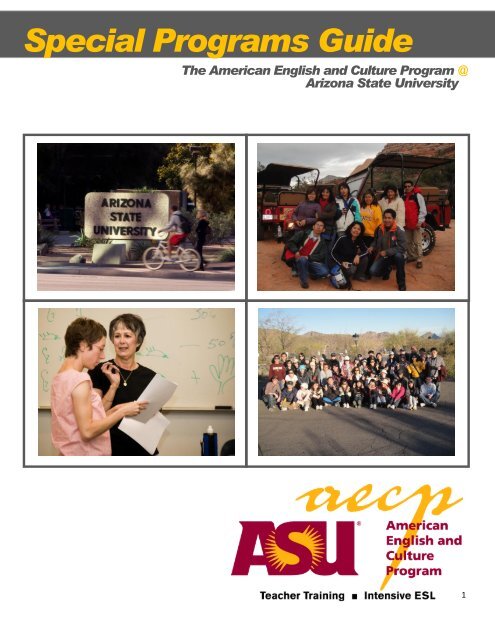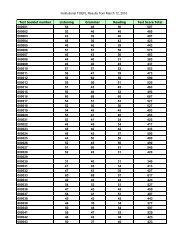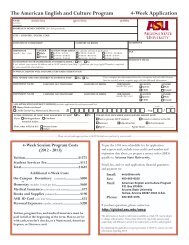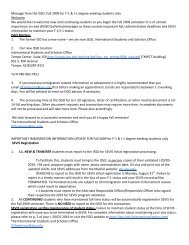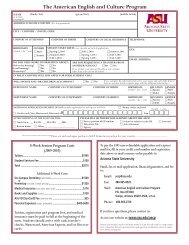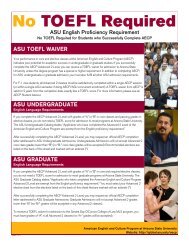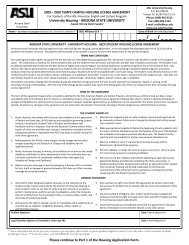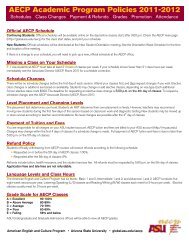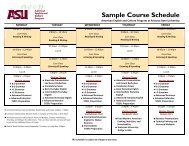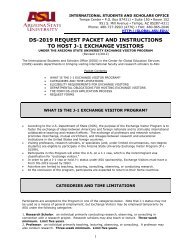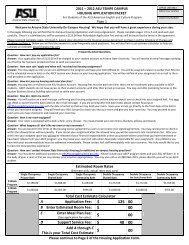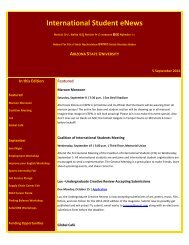Special Programs Guide - ASU International - Arizona State University
Special Programs Guide - ASU International - Arizona State University
Special Programs Guide - ASU International - Arizona State University
Create successful ePaper yourself
Turn your PDF publications into a flip-book with our unique Google optimized e-Paper software.
<strong>Special</strong> <strong>Programs</strong> <strong>Guide</strong>The American English and Culture Program @<strong>Arizona</strong> <strong>State</strong> <strong>University</strong>1
Used and new general and reference booksArt and technical suppliesAcademic school suppliesLargest selection of <strong>ASU</strong> apparel and giftsCalculators and electronicsTo see what <strong>ASU</strong> Bookstore‟s merchandise, click this link:http://bookstore.asu.edu/asu/home.aspx<strong>ASU</strong> Libraries<strong>ASU</strong> libraries have many resources, such as, books, newspapers, videos, and search databases, that can allbe accessed in the libraries or on their website. As a <strong>Special</strong> Program participant this is a great resource whenyou are doing research.Hayden LibraryHayden Library serves as the main library on the <strong>ASU</strong> Tempe campus. Located on Cady Mall, it houses booksand other research materials in the humanities and social sciences, including business and education. Thelibrary also houses many special collections.Architecture and Environmental Design LibrarySupporting the teaching and research missions of the College of Design, the AED Library is a component ofthe <strong>Arizona</strong> <strong>State</strong> <strong>University</strong> Libraries system, which has over three million volumes. The AED Library holdsover 50,000 items including books, periodicals, CD-ROMs, video recordings, and microforms. Subjectcoverage focuses strongly on design, including: architecture, landscape architecture, interior design, graphicdesign, industrial design, housing, and planning.Ross-Blakley Law LibraryThe collections of the Law Library are designed to meet the legal information needs of the faculty, the students,the <strong>University</strong> community and the public. We maintain a collection of primary authority and secondary sourcematerials. The Law Library is a participant in the Federal Library Depository Program. Some collectionemphases include Indian Law, English Legal History and a growing student Study Skills Collection.Music LibraryThe collection includes books on a wide range of musical topics: the history of music, biographies ofmusicians, music theory and composition, music education, and music therapy. A non-circulating referencecollection includes bibliographic works on various composers and musical genre, catalogs of other libraries,and musical dictionaries and encyclopedias in a variety of languages.Noble Science and Engineering LibraryThe Noble Science and Engineering Library, located on Tyler Mall on the Tempe campus, houses thecollections for astronomy, biology, chemistry, engineering, geography, geology, industry standards, maps,mathematics, medicine and physics. These collections include approximately 425,000 volumes, 1200 print andseveral thousand electronic journal subscriptions, 210,000 sheet maps, and 20,500 aerial photographs.Additionally, the library has a tutoring center as well as open and enclosed study spaces for both individualsand groups.<strong>ASU</strong> Computer LabsComputing Commons5
Computing Commons is the center of information technology and computing for <strong>ASU</strong>. The Commons‟ Atrium isan open access, 225-workstation computing site complete with Mac and Windows workstations. TheCommons also provides wired classrooms and meeting spaces.Computing Commons is located in the heart of campus, east of the Memorial Union on Orange Street.The first floor features the Computer Store that offers software and hardware at educational discounts.Note: <strong>ASU</strong> has access to wireless internet each student is set-up once they arrived and will have access at alltimes.AECP Computer LabAECP Computer Lab is open to all AECP students to work on homework, do research, or print. All PCs comewith basic Microsoft Office products. The AECP Computer Lab is located inside the AECP office.The American English and Culture Program (AECP)The <strong>ASU</strong> American English and Culture Program (AECP) has been offering specially designed, intensiveEnglish language instruction since 1974 to students from over 115 countries. AECP faculty and staff areprepared to help students meet their English goals, experience American culture and prepare for academicstudy.LocationAECP students have direct access to the entire Tempe campus, including student resource centers, computertechnology centers, recreational centers, classroom buildings and campus events.Regular Program LevelClasses are offered in eight-week sessions. There are five sessions offered each year. Students enroll in thenumber of sessions necessary to achieve the desired level of English proficiency. There are six levels ofEnglish offered, from basic to advance. It takes on full session (eight weeks) to complete a level.CoursesFull-time students study 21 hours per week, which includes two core courses in listening/speaking andreading/writing, and an elective course. Elective courses can be taken to earn special professional Englishcertificates in the areas of business English, science and technology, academic English, communications,American culture and fundamentals of English. More than 40 elective courses are offered in areas of studysuch as TOEFL preparation, grammar, academic and professional English, conversation, pronunciation,idioms, community service and American culture.SizeThe average class size for our regular program is 15 students.FacultyAll AECP teachers have at least a master‟s degree in teaching English as a second language or a related field.And many have overseas teaching experience.Group <strong>Programs</strong>AECP partners with universities, companies, governments and international organizations to offer specializedgroup programs designed to meet specific needs and schedules.Social and Cultural Activities6
AECP students experience a full range of program-sponsored trips and activities to experience Americanculture, <strong>Arizona</strong> and <strong>ASU</strong>. Activates include field trips to the Grand Canyon and Sedona, museums, picnics,professional sporting events, conversation clubs and more.TempeHistoryToday‟s City of Tempe, <strong>Arizona</strong> was shaped by a rich history of Native American and Hispanic culture andinfluences from entrepreneurial settlers from across the United <strong>State</strong>s.Following the establishment of Fort McDowell in 1865, enterprising farmers moved into what is now the City ofTempe, <strong>Arizona</strong>. They dug out the irrigation canals left by the prehistoric Hohokam people and built new onesto carry Salt River water to their fields. Valley farms soon supplied food to <strong>Arizona</strong>‟s military posts and miningtowns.The first settlers to move to the Tempe area were Hispanic families from southern <strong>Arizona</strong>. In 1872, some ofthese Mexican settlers founded a town called San Pablo east of Tempe Butte. Another settlement, known asHayden's Ferry, developed west of Tempe Butte. Within a few years, he had built a store and flourmill,warehouses and blacksmith shops, and a ferry. Both settlements grew quickly and soon formed onecommunity. The town was named Tempe in 1879. “Lord” Darrell Duppa is credited with suggesting the name.The sight of the butte, the wide river and the nearby expanse of green fields, reminded him of the Vale ofTempe in ancient Greece.In 1885, the <strong>Arizona</strong> legislature selected Tempe as the site for the Territorial Normal School, which trainedteachers for <strong>Arizona</strong>‟s schools. After World War II, the town's small teachers college had also grown, and in1958, the institution became <strong>Arizona</strong> <strong>State</strong> <strong>University</strong>.The Maricopa and Phoenix Railroad, built in 1887, crossed the Salt River at Tempe, linking the town to thenation's growing transportation system. The Tempe Land and Improvement Company was formed to sell lots inthe booming town. The City of Tempe, <strong>Arizona</strong> became one of the most important business and shippingcenters for the surrounding agricultural area.Prompted by Tempe‟s centennial in 1971, Mill Avenue was revitalized into an entertainment and shoppingdistrict. Today, the City of Tempe, <strong>Arizona</strong> is well known nationally as the home of <strong>ASU</strong>, the Insight Bowl andevents such as the P.F. Chang‟s Rock „n‟ Roll <strong>Arizona</strong> Marathon & ½ Marathon and Ford Ironman <strong>Arizona</strong>. It isthe seventh largest city in <strong>Arizona</strong>, with a strong modern economy based on commerce, tourism andtechnology.Information retrieved from: http://www.tempecvb.com/get-to-know-tempe/History.aspx<strong>ASU</strong> is located near downtown Tempe, about a 10-minute drive from Phoenix Sky Harbor <strong>International</strong> Airport.Tempe has a population of 160,000 and was voted “One of the 10 best college towns in America,” according toThe New York Times; Tempe‟s many attractions include restaurants, cinemas, shopping, street fairs and theTempe Town Lake—all within easy walking distance of the university.7
<strong>Arizona</strong>Five Regions<strong>Special</strong> Program participants will get the opportunity to travel around <strong>Arizona</strong> and see many of its attractions,museums, and natural wonders. We also encourage students to venture out on their own in any of <strong>Arizona</strong>‟sfive regions.Phoenix and Central <strong>Arizona</strong>Metropolitan Phoenix is world renowned as the lifestyle capital of the American Southwest for this open-airlifestyle with an abundance of mountain preserves and outdoor recreational opportunities. <strong>Arizona</strong>‟s SonoranDesert has a variety of desert plants and wildlife as well as opportunities to hike and go on a Jeep tour.Explore Native American arts and culture at the Heard MuseumLean desert survival secrets at Desert Botanical GardensAttend professional athletic events—Phoenix Coyotes, <strong>Arizona</strong> Diamondbacks, Phoenix Suns, <strong>Arizona</strong>CardinalsScience CenterInvestigate animals at the Wildlife World ZooExplore art galleries in the Phoenix Art MuseumRide horsebackCatch a Broadway show, dance or concert at Grady Gammage AuditoriumNorthern <strong>Arizona</strong>A visit to Northern <strong>Arizona</strong> wouldn‟t be complete without exploring Grand Canyon National Park, one of theSeven Natural Wonders of the World. But you‟ll also want to take in Sedona‟s red rocks; Flagstaff‟s forestedmountains and Monument Valley‟s sandstone spires.Investigate hidden coves of Lake Powell‟s shorelineShop Tlaquepaque, a replica of a Mexican villaTour rugged terrain in a spectacular Jeep tour in SedonaTo learn more, please visit:http://www.arizonaguide.com/http://www.azot.gov/http://www.arizonabeautiful.com/Information retrieved from <strong>Arizona</strong> Office of Tourism, 2007 Official <strong>State</strong> Visitor‟s MapGrand CanyonThe Grand Canyon is a wonderful year-round vacation destination and has millions of facts, info, stories,history, geology and areas to study. Learning the history and interesting facts about the Grand Canyon can bea lifelong venture of research and exploration. We thought you might enjoy some fast facts to increase yourbasic knowledge of this natural wonder of the world.The Grand Canyon is 277 miles long and up to 18 miles wide8
Average depth of about one mileIncludes approximately 70 species of mammals, 250 species of birds, 25 types of reptiles and fivespecies of amphibiansWas made a national monument in 1908 and became a national park in 1919Is 190 miles longContains some 277 miles of the Colorado RiverIs populated by five Indian tribes: The Hopi, Navajo, Havasupai, Paiute and HualapaiInformation retrieved from National Geographic Visitor Center Grand Canyon, Grand Canyons Facts and FiguresSedonaOften called "Red Rock Country", this picturesque city is surrounded by red-rock monoliths named Coffeepot,Cathedral and Thunder Mountain. At the north end of the city is the stunning Oak Creek Canyon, abreathtaking chasm that is wildly wonderful.TransportationInformation retrieved from <strong>Arizona</strong> Official Tourism Bureau: http://www.visitsedona.com/<strong>Special</strong> <strong>Programs</strong> participants will most likely receive a U-Pass at orientation which will give them access to allpublic transportation.U-PassThe <strong>ASU</strong> U-Pass offers unlimited access on Valley Metro bus routes and the METRO light rail. The U-Passyou receive from Public and Transit Services (PTS) is already activated. However, you must validate every tripbefore boarding the light rail each time. Simply touch the back of your U-Pass to the orange card reader("target") located on the transit vending machine kiosk at each boarding station.Upon touching a valid U-Pass to the orange target, an audible "ding" can be heard, the screen will display a"thank you" message and will show the expiration date of the U-Pass, and the target light will turn from yellowback to green. No type of printed confirmation or ticket is issued.Be prepared to show proof of a valid fare to METRO fare inspectors by always having your U-Pass and SunCard with you while riding light rail and by always validating the U-Pass before boarding the train. By validatingyour U-Pass, you avoid fare violation fines which range from $50-500.Light railMETRO light rail runs through the heart of the Tempe and Downtown Phoenix campuses. It provides quick andefficient service between the two campuses as well as to a number of destinations in the greater-Phoenix area,including a connection to Sky Harbor <strong>International</strong> Airport.City Bus and Orbit9
The City of Tempe and the City of Phoenix both offer free neighborhood circulator shuttles.City of Tempe - OrbitCity of Phoenix - DASHValley Metro, the public bus agency that provides service to nearly every city in the greater Phoenix area,operates throughout the Valley including stops on all four <strong>ASU</strong> campuses and Sky Harbor <strong>International</strong> Airport.<strong>ASU</strong> students, faculty and staff can ride Valley Metro buses by obtaining an <strong>ASU</strong> U-Pass.Climate<strong>Arizona</strong> is world famous for its beautiful weather. Many people come here to escape cold climates and to enjoyan outdoor lifestyle all year. The weather is mild and dry, fall through spring, with an average of 321 sunnydays a year. During the warm summer months, facilities are air-conditioned. Light clothing is common oncampus most of the year, with a jacket needed for a short time during the winter monthsAverage temperature in July: 91.4 F/33 CAverage temperature in January: 54.2 F/12.33 C<strong>Arizona</strong> has a very dry heat and in July most days get up to 107 F/ 41-42 C. It is very sunny and requirespeople to protect themselves with sunblock or sunscreen, umbrella, sunglasses or baseball hat. Drink lots ofwater! Do not wait until you feel thirsty but continue to hydrate yourself throughout the day. If your doctor asksyou to limit the amount of fluids you drink, call and ask how much is safe for you to drink when it is hot. Avoiddrinks that contain caffeine, alcohol or a lot of sugar.Everywhere you go will have air-conditioning so do not worry, there is indeed air-conditioning in yourapartment, in our classrooms and any shopping mall/grocery store.To learn more about <strong>Arizona</strong> weather visit these websites:http://countrystudies.us/united-states/weather/<strong>Arizona</strong>/tempe.htmhttp://www.wrh.noaa.gov/psr/ShoppingElectronicsMost electronics in the United <strong>State</strong>s are cheaper than in other countries. This is a good opportunity for <strong>Special</strong>Program participants to shop around for a new electronic.Most electrical outlets in the United <strong>State</strong>s operate with a voltage of 120 volts, 60 cycles. If your equipmentrequires different volts, bring a converter/adapter. You can purchase a laptop in the U.S. for a reasonableprice. You can also benefit from partnerships <strong>ASU</strong> has with cell phone, computing and software vendors.<strong>ASU</strong> Computer Store in the <strong>ASU</strong> Computing Commons offers discount prices on computer products tostudents with an <strong>ASU</strong> suncard.Here is a list of electronic stores and their websites near Tempe:Radio Shack: http://www.radioshack.com/storeLocator3/index.jsp?clickid=rsk_header_storeLocator10
Best Buy: http://www.bestbuy.com/site/olspage.jsp?id=cat12092&type=page&_requestid=312396Fry‟s Electronics: http://www.frys.com/isp/tempe.htmlBookstoresThere are many bookstores located in the Tempe area. Borders, Barnes and Noble, and Changing Handshave a wide variety of new books ranging from new fiction to classical plays.To see merchandise visit these websites:New booksBorders: http://www.borders.com/online/store/LocatorResultsBarnes and Noble:http://storelocator.barnesandnoble.com/storelocator/stores.aspx?pagetype=storeList&city=Tempe+&state=AZ&zip=New and Used BooksChanging Hands: http://changinghands.com/Bookmans: http://www.bookmans.com/our-stores/mesaTeaching SuppliesTeaching supplies can be found at the following stores:Teaching Stuffhttp://www.teachingstuff.com/Packing ListHow Arizonians Dress<strong>Arizona</strong> is a casual society. People of all ages wear comfortable clothing to accommodate the warm summers.<strong>ASU</strong> students are seen with baseball caps, flip-flops, shorts, and t-shirts on summer days. In the winters mostdays will require a jacket and long pants. It is not surprising to see professors walking around in jeans and ashirt or in trousers and a necktie.What to PackJeans or KhakisShortsBusiness casual shirts (polo style or button up)Light JacketSwimsuitComfortable shoes (ex: tennis shoes, sandals…)HatCameraSunglassesSunscreenElectrical converters/adapters11
One formal outfit (for formal graduation dinner)Small gift for host family (ex: a small item representing your country)Other Important DocumentsPassportCopy of PassportMMRInsurance documentation (if not on AECP insurance)I-20 (if F-1 holder)JI (if J-2 holder)Contact InformationTo learn more about AECP or if you have any questions please use the following contact information:By Postal MailAmerican English and Culture Program<strong>Arizona</strong> <strong>State</strong> <strong>University</strong>P.O. Box 873504Tempe, <strong>Arizona</strong> 85287-3504U.S.A.By E-mailaecp@asu.eduBy Telephone1-480-965-2376By Fax1-480-965-8529In PersonEngineering Center Annex (ECANX)Room 101<strong>ASU</strong> Tempe CampusAECP Office HoursMonday through Friday, 8:00 AM - 5:00 PMWebsitehttp://global.asu.edu/aecpAdam Henry, M.Ed.Assistant DirectorE-mail: adam.keith.henry@asu.eduTelephone: 1-480-965-309312


